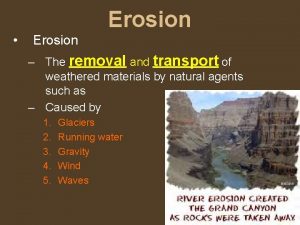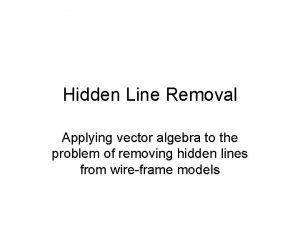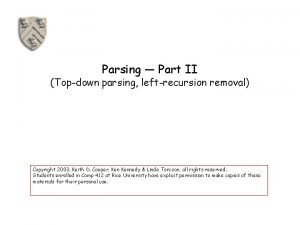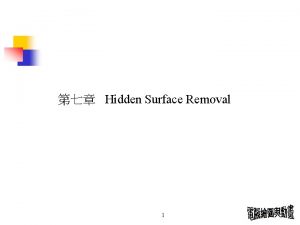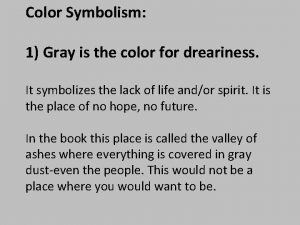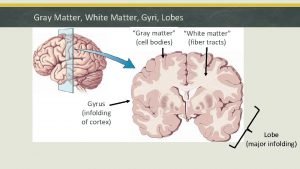Color 2 Gray SaliencePreserving Color Removal Amy A

















![Naïve Method Transferring color to grayscale images [Walsh, Ashikhmin, Mueller 2002] • Find a Naïve Method Transferring color to grayscale images [Walsh, Ashikhmin, Mueller 2002] • Find a](https://slidetodoc.com/presentation_image_h/14ef0d099b30cbac3277d1716007781c/image-18.jpg)












- Slides: 30

Color 2 Gray: Salience-Preserving Color Removal Amy A. Gooch Sven C. Olsen Jack Tumblin Bruce Gooch

• Visually important image features often disappear when color images are converted to grayscale.


• we want digital images to preserve a meaningful visual experience, even in grayscale.

preserve the salient features of the color image The algorithm introduced here reduces such losses by attempting to preserve the salient features of the color image. The Color 2 Gray algorithm is a 3 -step process: 1. convert RGB inputs to a perceptually uniform CIE L∗a∗b∗ color space, 2. use chrominance and luminance differences to create grayscale target differences between nearby image pixels, and 3. solve an optimization problem designed to selectively modulate the grayscale representation as a function of the chroma variation of the source image. The Color 2 Gray results offer viewers salient information missing from previous grayscale image creation methods.

Parameters • θ: controls whether chromatic differences are mapped to increases or decreases in luminance value (Figure 5). • α: determines how much chromatic variation is allowed to change the source luminance value (Figure 6). • μ: sets the neighborhood size used for chrominance estimation and luminance gradients (Figure 7).





IEEE TRANSACTIONS ON PATTERN ANALYSIS AND MACHINE INTELLIGENCE, VOL. 32, NO. 9, SEPTEMBER 2010 Color to Gray: Visual Cue Preservation Mingli Song, Member, IEEE, Dacheng Tao, Member, IEEE, Chun Chen, Xuelong Li, Senior Member, IEEE, and Chang Wen Chen, Fellow, IEEE • algorithm based on a probabilistic graphical model with the assumption that the image is defined over a Markov random field. • color to gray procedure can be regarded as a labeling process to preserve the newly well-defined visual cues of a color image in the transformed gray-scale image • three cues are defined namely, color spatial consistency, image structure information, and color channel perception priority • visual cue preservation procedure based on a probabilistic graphical model and optimize the model based on an integral minimization problem.



Colorization by example R. Irony, D. Cohen-Or, D. Lischinski Eurographics Symposium on Rendering (2005)

Motivation n. Colorization, is the process of adding color to monochrome images and video. n. Colorization typically involves segmentation + tracking regions across frames - neither can be done reliably – user intervention required – expensive + time consuming n Colorization by example – no need for accurate segmentation/region tracking

The method • Colorize a grayscale image based on a user provided reference. Reference Image

![Naïve Method Transferring color to grayscale images Walsh Ashikhmin Mueller 2002 Find a Naïve Method Transferring color to grayscale images [Walsh, Ashikhmin, Mueller 2002] • Find a](https://slidetodoc.com/presentation_image_h/14ef0d099b30cbac3277d1716007781c/image-18.jpg)
Naïve Method Transferring color to grayscale images [Walsh, Ashikhmin, Mueller 2002] • Find a good match between a pixel and its neighborhood in a grayscale image and in a reference image.

By Example Method

1. training 2. classification 3. color transfer Overview

Training stage Input: 1. The luminance channel of the reference image 2. The accompanying partial segmentation Construct a low dimensional feature space in which it is easy to discriminate between pixels belonging to differently labeled regions, based on a small (grayscale) neighborhood around each pixel.

Training stage Create Feature Space (get DCT cefficients)

Classification stage For each grayscale image pixel, determine which region should be used as a color reference for this pixel. One way: K-Nearest –Neighbor Rule Better way: KNN in discriminating subspace.

KNN in discriminating subspace Originaly sample point has a majority of Magenta

KNN in discriminating subspace Rotate Axes in the direction of the intra-difference vector

KNN in discriminating subspace Project Points onto the axis of the inter-difference vector Nearest neigbors are now cyan

KNN Differences Matching Use a median filter to create a cleaner classification Simple KNN Discriminating KNN Classification

Color transfer Using YUV color space YUV

Final Results

 Red green blue purple
Red green blue purple Removal of water hardness
Removal of water hardness St mary's county tree removal permit
St mary's county tree removal permit Readily achievable barrier removal
Readily achievable barrier removal The removal and transport of soil
The removal and transport of soil Miranda pest control
Miranda pest control The effects of coyote removal in texas
The effects of coyote removal in texas Fatpipe logo
Fatpipe logo Laser tattoo removal training uk
Laser tattoo removal training uk Buccal fat removal in dubai
Buccal fat removal in dubai Indian removal act of 1830
Indian removal act of 1830 Jieshu
Jieshu Mechanical material removal
Mechanical material removal Biomedical waste introduction
Biomedical waste introduction Engine removal service
Engine removal service Avl tree removal
Avl tree removal Horizontal mattress
Horizontal mattress Hidden line removal
Hidden line removal Defect amplification and removal
Defect amplification and removal Graph suffix medical terminology
Graph suffix medical terminology Gyro tip post removal
Gyro tip post removal Littauer suture removal
Littauer suture removal Wet etch clean filters
Wet etch clean filters Single image haze removal using dark channel prior
Single image haze removal using dark channel prior Left recursion
Left recursion Removal
Removal Parasitism
Parasitism Wee cho into1
Wee cho into1 Fat villains
Fat villains Eliminating epsilon productions from cfg
Eliminating epsilon productions from cfg Suture size chart
Suture size chart




